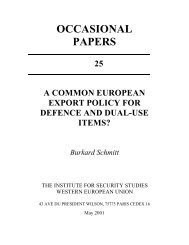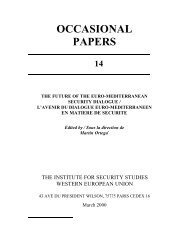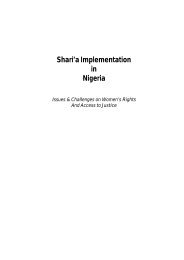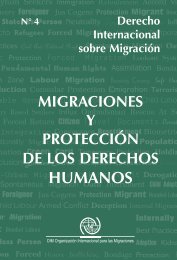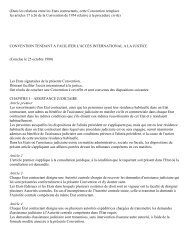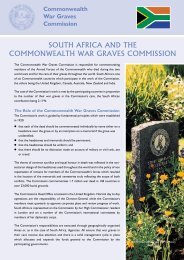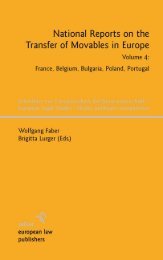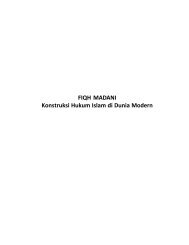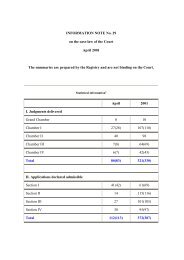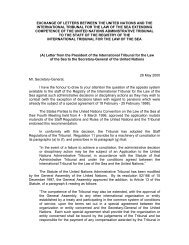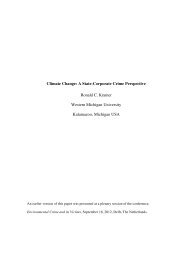Party Autonomy in International Property Law - Peace Palace Library
Party Autonomy in International Property Law - Peace Palace Library
Party Autonomy in International Property Law - Peace Palace Library
Create successful ePaper yourself
Turn your PDF publications into a flip-book with our unique Google optimized e-Paper software.
D. Assignment; F<strong>in</strong>ancial Instruments; Insolvency <strong>Law</strong><br />
State where the debtor has an establishment as def<strong>in</strong>ed <strong>in</strong> Article 2 (h)<br />
EIR is a foreseeable risk; hence, also <strong>in</strong> such cases the protection of legitimate<br />
expectations may not be at stake where the transaction <strong>in</strong>volved the<br />
transfer or encumbrance of assets situated <strong>in</strong> that State.<br />
12.2.4. Articles 5 (4) and 7 (3) EIR<br />
The system thus laid down <strong>in</strong> Articles 4 and 13 EIR also applies with<br />
respect to the reversal of the transfer or encumbrance of assets. With<br />
respect to proprietary rights (<strong>in</strong>clud<strong>in</strong>g reservation of ownership), this<br />
has been laid down explicitly <strong>in</strong> Articles 5 (4) and 7 (3) EIR. Pursuant to<br />
these provisions, the fact that rights <strong>in</strong> assets located <strong>in</strong> a Member State<br />
other than the State where the <strong>in</strong>solvency proceed<strong>in</strong>g has been opened<br />
are ‘isolated’ from the effects of the ma<strong>in</strong> <strong>in</strong>solvency proceed<strong>in</strong>g ‘shall not<br />
preclude actions for voidness, voidability or unenforceability as referred<br />
to <strong>in</strong> Article 4 (2) (m)’.<br />
Even though not explicitly referred to <strong>in</strong> Articles 5 (4) and 7 (3) EIR, the<br />
defence provided for <strong>in</strong> Article 13 EIR can also be <strong>in</strong>voked by the creditor<br />
who has obta<strong>in</strong>ed a proprietary right with<strong>in</strong> the terms of Articles 5 and 7<br />
EIR. 12 If, for example, a Spanish liquidator, appo<strong>in</strong>ted <strong>in</strong> ma<strong>in</strong> proceed<strong>in</strong>gs<br />
opened <strong>in</strong> Spa<strong>in</strong>, <strong>in</strong>vokes the voidness or voidability of a right of pledge<br />
created <strong>in</strong> assets situated <strong>in</strong> the Netherlands, the pledgee cannot claim<br />
that, pursuant to Article 5 (1) EIR, the right of pledge is not affected by<br />
the claw back provisions that are <strong>in</strong> place under Spanish <strong>in</strong>solvency law.<br />
This is clearly expressed by Article 5 (4) IR. The pledgee can, however,<br />
on the basis of Article 13 EIR, claim that the right of pledge is valid and<br />
enforceable aga<strong>in</strong>st the <strong>in</strong>solvent estate if it cannot be challenged under<br />
Dutch (<strong>in</strong>solvency) law.<br />
12.2.5. Lex causae: the law govern<strong>in</strong>g the proprietary<br />
aspects of the transfer or encumbrance of assets<br />
The EC Insolvency Regulation has adopted a system whereby a juridical<br />
act can only be challenged successfully if it is subject to reversal under<br />
the lex concursus as well as under the lex causae, <strong>in</strong>clud<strong>in</strong>g its <strong>in</strong>solvency<br />
12<br />
Cf. Veder 2004 (footnote 7), p. 316.<br />
268<br />
P. M. Veder<br />
© sellier. european law publishers<br />
www.sellier.de



